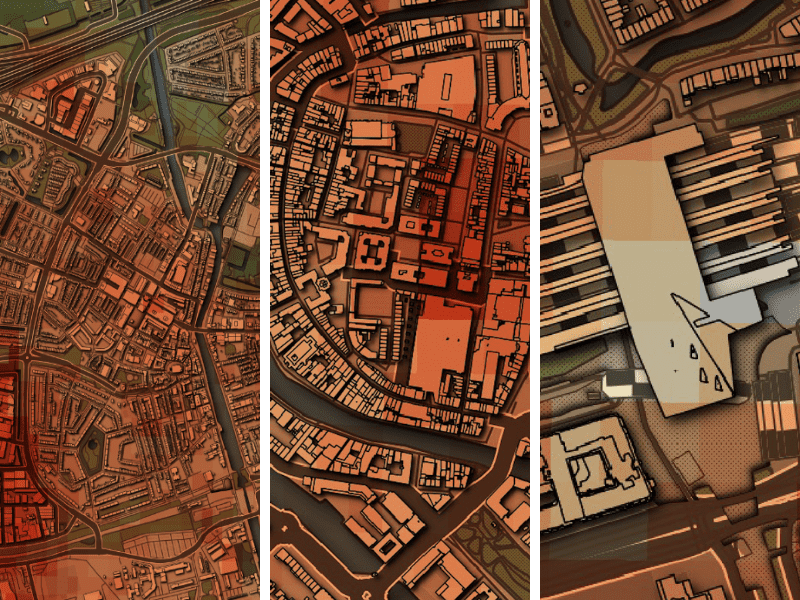
Why haven’t the really big cities in the Netherlands been covered in this column yet? Well, the editor on duty wanted to save these for future special episodes. Because this series is more or less halfway, we are going to zoom in on the Rotterdam metropolitan area today. Where were people drenched in sweat in the Maasstad? The data from the NASA ECOSTRESS satellite, which flew over the Netherlands on a sun-baked Friday afternoon to measure ground temperatures, holds the answer.
That a city can heat up so intensely during a hot summer afternoon is common knowledge. As a rule, a city park will tend to have much cooler temperatures than industrial areas. However, even in city centers and residential areas, the differences from street to street can be quite substantial. This is also the case in Rotterdam. An international port city on a major river with a lot of high-rise buildings, by Dutch standards.
This is the fifth story in this series, in which three different cities are covered twice a week. This time around it is slightly different. For the mid-finals, an especially large research area has been chosen: from De Kuip to Blijdorp Zoo. But first, let’s take another fresh look at the inner city.
Hotspots of the Maasstad
In order to check whether there is not a smaller specimen of a heat island tucked away after all, the interactive tool above can be used to zoom in on a street level. In any case, Rotterdammers do not really seem to have any large heat islands in the inner city. Even though the 010 area was roughly the same in terms of air temperature on 12 August and its population, the above map makes it easy to find areas where the mercury on the ground surface rose above 45 °C.
Nowhere did it get as hot in the city center as on the roof of the Erasmus MC on August 12. Yet this very localalized 46.6 ºC can still be considered modest. The basketball court in front of the Marnix Gymnasium (45.8ºC), around the Beurs subway station near the Bijenkorf (45.4ºC), Schouwburgplein (44.8ºC) and the Witte de Withstraat are examples of heat islands that look rather unimpressive compared to The Hague city center.
And where the palace gardens of Noordeinde were the only place where the ground surface area remained under 40°C, those looking to cool off can choose to head towards the Stationsplein, the Museumpark or just a little further away to the Blijdorp Zoo. Make sure you do actually go into the park though and not go shopping at the Meubelboulevard, which happens to be a very conspicuous heat magnet.

See any beads of sweat in the 010 region?
The zoomed-in map of the entire area of Rotterdam north of the Maas river shows very clearly that the gravity of the problem also varies widely from district to district. Kralingen, the Tarwebuurt and Katendrecht appear to remain several degrees cooler than, for example, Tussendijken, Feijenoord and the Oude Noorden. The hottest areas that do stand out on this map are each and every one of them industrial areas or port areas.
If you want to know what a 50°C on the ground feels like, the best place to try is in the Spaanse Polder industrial terrain, where a blazing 51°C is the hottest location so far in the whole city (and all of the western Netherlands). But given that the west of the country tends to stay a few degrees cooler on summer days than the east, it would also be rather unusual for a national record to be broken here.

Neighbors facing the heat?
The urban agglomeration of Rotterdam encompasses dozens of towns that have practically melted together over the past few decades. And since heat island management is mainly the job of municipalities and a lot of neighboring cities are not keen on being eaten up by 010, the policies of three different municipalities can be spotted on a map. This second map depicts the ECO stress data of Vlaardingen on the west side and Schiedam, which borders Rotterdam.
Between the sweltering business parks, characteristic harbor docks and the meandering Nieuwe Maas River, the city center of Schiedam doesn’t exactly seem to be heat-resistant either. In the streets near the Winkelpassage in particular, the mercury soars to almost 47 °C. Awfully high values for this ‘cool’ part of the Netherlands. Nor is it limited here to shopping districts or business parks.
Residential areas of Schiedam-East and South are also clearly marked with red patches, with ground surface measurements that are not particularly memorable, with 48.8°C along the Rotterdams Dijk as the outlier. This differs by up to 8 degrees with the circumstances in the northwestern districts.
A few kilometers away in the Vlaardingen shopping district, the temperature of 45°C was barely reached under the roof of the shopping arcade and in the Stationsstraat. Oostwijk is a comparatively warm neighborhood, while Holy Zuid offers ample cooling. The Vopwijk industrial estate is the hottest spot in the city, with ground temperatures reaching 49 °C. It seems that the Klauter Forest in the far west is the ultimate oasis for cooling in this region.

Coolsingel
Of the three municipalities in this episode, Rotterdam seems to have its affairs in order best as far as heat management is concerned.
Because a very large area was put under the microscope this week, the top ten does feature five new hottest locations: two in Rotterdam and Schiedam and one in Vlaardingen.
Can you find them somewhere between Flanders and Kralingen on this ultra-wide closing map?
Other articles
Episode 2 - Arnhem, Eindhoven and The Hague
Episode 3 - Tilburg, Groningen and Utrecht
Episode 4 - Nijmegen, Almere and Leiden







